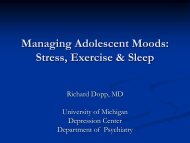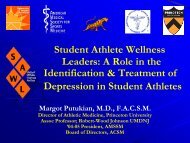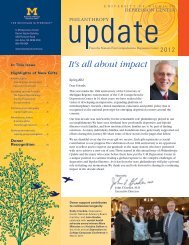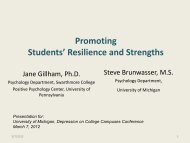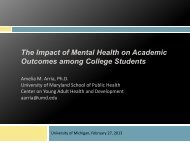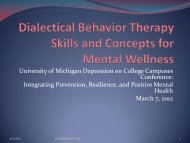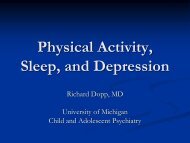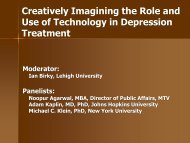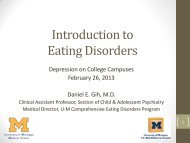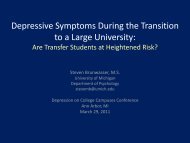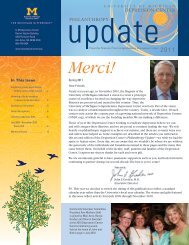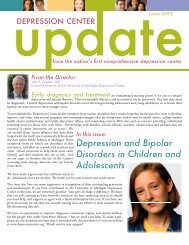A Game Plan to Address Student-Athlete Mental Health and ...
A Game Plan to Address Student-Athlete Mental Health and ...
A Game Plan to Address Student-Athlete Mental Health and ...
- No tags were found...
Create successful ePaper yourself
Turn your PDF publications into a flip-book with our unique Google optimized e-Paper software.
A <strong>Game</strong> <strong>Plan</strong> <strong>to</strong> <strong>Address</strong><strong>Student</strong>-<strong>Athlete</strong> <strong>Mental</strong> <strong>Health</strong><strong>and</strong> Substance Use Issues11th Annual University of MichiganDepression on College Campuses ConferenceFebruary 27, 2013Chris Carr, PhD, HSPPSt Vincent Sports PerformanceIndianapolis, IndianaBarb Hansen, LMSWAthletics CounselorUniversity of MichiganKenneth Chew, Jr., Psy.D., HSPP<strong>Student</strong> Counseling CenterIndiana State UniversityMary WilfertNCAA <strong>Health</strong> <strong>and</strong> Safety
NCAA Structure <strong>and</strong> FunctionsCompetitive Safeguards <strong>and</strong> Medical Aspects of Sports
NCAA Membership PrinciplesPrinciple of <strong>Student</strong>-<strong>Athlete</strong> Well-Being <strong>Health</strong> <strong>and</strong> Safety: It is the responsibility of each member institution<strong>to</strong> protect the health of <strong>and</strong> provide a safe environment for each of itsparticipating student-athletes.Principle of Sportsmanship <strong>and</strong> Ethical Conduct In order <strong>to</strong> promote the character development of participants, <strong>to</strong>enhance the integrity of higher education <strong>and</strong> <strong>to</strong> promote civility insociety, student-athletes, coaches <strong>and</strong> all others associated withthese athletics programs <strong>and</strong> events should adhere <strong>to</strong> fundamentalvalues as respect, fairness, civility, honesty <strong>and</strong> responsibility.
Critical <strong>Student</strong>-<strong>Athlete</strong> H & S IssuesAthletics Participation• Banned Drugs <strong>and</strong> DrugTesting• Injury Prevention <strong>and</strong>Recovery• Medical Insurance• Risk Minimization• Sports Safety RulesCollege / <strong>Student</strong> Life/Personal Wellness• Anxiety <strong>and</strong>Depression• Fitness <strong>and</strong> Nutrition• Hazing• Life Transitions• Relationships• Sleep• Substance Abuse
2010 NCAA GOALS Survey: My athletics participationis important in preparing me for life after graduation(% Responding Agree or Strongly Agree)BaseballMen’sBasketballDivision IFootballAll OtherMen’sSportsWomen’sBasketballAll OtherWomen’sSportsN 79% 77% 70% 71% 66% 61%Division IIN 69% 74% 69% 65% 64% 52%Division IIIN 66% 66% 69% 60% 60% 50%Note: Endorsement of <strong>to</strong>p two scale points on 6-point scale
Winning is more important <strong>to</strong> me than goodsportsmanship(% Responding Somewhat Agree or Strongly Agree)BaseballMen’sBasketballDivision IFootballAll OtherMen’sSportsWomen’sBasketballAll OtherWomen’sSportsN 48% 47% 50% 36% 25% 15%Division IIN 46% 44% 43% 33% 21% 15%Division IIIN 46% 44% 42% 31% 18% 10%Note: Endorsement of <strong>to</strong>p two scale points on 5-point scale
Most of Us Don’t . . .<strong>Student</strong>-<strong>Athlete</strong>s Reporting “Never Used”by Substance:• Anabolic Steroids – 98.6 percent• Ephedrine – 97.7 percent• Amphetamines – 96.3 percent• Cocaine – 95.7 percent• Narcotics – 94.1 percent• Spit Tobacco – 75.1 percent• Cigarettes – 73.8 percent• Marijuana – 62.3 percent• Alcohol – 12.6 percent2009 NCAA Substance Use Survey
Heavy Drinking Trends2009 NCAA – of Those Who Drink2005 2009Overall 5+ drinks in one sitting 59.7% 59%Overall 10+ drinks in one sitting 18.4% 17.4%Women 4+ drinks in onesitting59.2 60.3Men 5+ drinks in one sitting 72.5 68.8Men 10+ drinks in one sitting 28.6% 26.1%
Negative Consequences from Use2009 NCAA – How many times in 12 monthsExperienced as a result of alcohol/druguseNever 1-2 3-5 6+Hangover 33.6% 25.7% 16.1% 24.6%Missed Class 66% 17.8% 9% 7.3%Poor Test or Project Performance 76.1% 15.6% 5.4% 2.8%Missed or Late <strong>to</strong> Practice 93.8% 4.9% 1% .3%Poor Athletic Performance 79.3% 14% 4.4% 2.2%Driven Under the Influence 76.9% 13% 4.8% 5.3%Memory Loss 70% 17.3% 6.8% 6%Done Something Later Regretted 62.4% 23.6% 10.4% 3.8%
Alcohol on Performance• Causes dehydration which slowshealing• Requires increased conditioning<strong>to</strong> manage weight• Slows muscle recovery• Inhibits absorption of nutrients• Interferes with ability <strong>to</strong> sharplyfocus• Hampers memory <strong>and</strong> retention10
2009 Drug Studies—Comparative DataPercent reported use in last *30 days; in last **12 MonthsNCAACORE[2006]NSDUHcollegeMTF12thgradeMTF19-24Alcohol * 64.8% 71.8% 63.9% 44% 68.1%Cigarettes* 7.9% 26.2% [<strong>to</strong>bacco] 27.1% 20% 23.5%Spit Tobacco* 12.3% [combined withabove]Marijuana 9.6%*22.6%**Amphetamines**Cocaine 0.5%*1.3%**AnabolicSteroids**16.8%*30.1%**12.7% 8% --20.2%*32%**3.7% 6.2% -- 7.5% --2.2%*5.2%**1.4%*5.3%** 3.5%**0.4% 0.6% -- 1.5% --Banned for use by NCAA student-athletes18.5%*32.1%**1.8%*5.7%**
American College <strong>Health</strong> Association – National College<strong>Health</strong> Assessment 2009-2010 Data -- Overview• Data source: American College <strong>Health</strong> Association. American College<strong>Health</strong> Association – National College <strong>Health</strong> Assessment, Fall 2009<strong>and</strong> Fall 2010 (National College <strong>Health</strong> Assessment II). Baltimore. MD:American College <strong>Health</strong> Association; (2013-02-15).• Fall 2009 <strong>and</strong> fall 2010 administrations included 80 institutions <strong>and</strong>nearly 54,000 unique respondents.• Although the characteristics of the responding institutions are diverse,including public/private, geographic location, student population, etc.,due <strong>to</strong> the limited institutional participation, this is not considerednationally representative.• At this time, we are unable <strong>to</strong> match responding institutions with NCAAinstitutional identifiers (e.g., NCAA division). Because of this, it ispossible institutions are included in the following analyses that are notNCAA member institutions.
American College <strong>Health</strong> Association – National College<strong>Health</strong> Assessment 2009-2010 Data -- Overview• Survey items address students’ behavior <strong>and</strong> attitudes on a broadmixture of health <strong>and</strong> safety issues. Of most interest <strong>to</strong> the NCAA were<strong>to</strong>pics including: stress, aggressive behavior, mental health well-being<strong>and</strong> outside fac<strong>to</strong>rs affecting academic performance.• Added for the first time in 2008 was a question regarding whether therespondent was a varsity athlete. The following comparisons are basedon responses <strong>to</strong> this question. Among the respondents in 2009 <strong>and</strong>2010, approximately 7.5% self-identified as a varsity student-athlete.
Prescription Medication Use without aprescription --in the Last 12 Months –Males Females OverallSANon-AthSANon-AthSANon-AthAntidepressants 3% 2 % 2% 3% 3% 3%Erectile Dysfunction (menonly)2% 1% NA NA 2% 1%Pain Killers 10% 8% 7% 8% 9% 8%Sedatives 4% 4% 2% 3% 3% 4%Stimulants 6% 6% 4% 5% 5% 5%*highlighted items indicate a statistically significant difference, chi-square, p
Aggressive Behavior in the last 12 months –SAMales Females OverallNon-AthSANon-AthSANon-AthBeen in a physical fight 24% 12% 6% 5% 14% 7%Been physicallyassaulted (excludingsexual assault)Been verballythreatenedIn an emotionallyabusive relationship9% 6% 4% 4% 6% 4%38% 27% 19% 17% 27% 21%8% 7% 10% 11% 9% 10%In a physically abusiverelationship3% 2% 3% 2% 3% 2%*highlighted items indicate a statistically significant difference, chi-square, p
Indica<strong>to</strong>rs of Depression –Males Females OverallSA Non-Ath SA Non-Ath SA Non-AthFelt things were hopeless 47% 58% 62% 70% 56% 66%Felt overwhelmed by all youhad <strong>to</strong> doFelt so depressed that it wasdifficult <strong>to</strong> function71% 82% 91% 94% 82% 90%36% 46% 45% 55% 41% 52%Felt very sad 59% 70% 76% 83% 68% 78%Felt very lonely 56% 68% 72% 80% 65% 76%Felt exhausted (not fromphysical activity)66% 79% 85% 91% 77% 87%Felt overwhelming anxiety 42% 55% 59% 69% 52% 64%Felt overwhelming anger 49% 55% 53% 61% 51% 59%Intentionally cut, burned,bruised, or otherwise injuredyourself12% 13% 16% 18% 14% 16%Seriously considered suicide 13% 17% 14% 20% 14% 19%Attempted suicide 6% 6% 7% 8% 6% 8%Percents indicate proportion responding event has occurred in their lifetime.*highlighted items indicate a statistically significant difference, chi-square, p
<strong>Mental</strong> <strong>Health</strong> Diagnoses in the last 12 months –Males Females OverallSA Non-Ath SA Non-Ath SA Non-AthAnorexia 2% 1% 2% 1% 2% 1%Anxiety 4% 6% 9% 12% 7% 10%ADHD 4% 4% 4% 3% 4% 4%Bipolar Disorder 2% 1% 1% 1% 2% 1%Bulimia 2% 1% 2% 1% 2% 1%Depression 4% 6% 8% 11% 6% 9%OCD 3% 2% 2% 2% 2% 2%Schizophrenia 2%
Within the last 12 months, have you found thefollowing traumatic or difficult <strong>to</strong> h<strong>and</strong>le –SAMales Females OverallNon-AthSANon-AthSANon-AthAcademic 33% 38% 44% 47% 39% 44%Career-related issue 15% 21% 15% 24% 15% 23%Family problems 20% 19% 29% 32% 25% 28%Intimate relationships 26% 26% 32% 33% 29% 30%Other socialrelationships17% 19% 26% 26% 22% 24%Finances 24% 30% 29% 38% 27% 35%Personal appearance 11% 14% 21% 25% 17% 21%Personal health issue 8% 12% 16% 20% 13% 17%Sleep difficulties 17% 21% 21% 26% 19% 24%*highlighted items indicate a statistically significant difference, chi-square, p
Within the last 12 months, have any of the followingnegatively affected your academic performance –Males Females OverallSA Non-Ath SA Non-Ath SA Non-AthAlcohol Use 6% 5% 4% 3% 5% 4%Chronic Pain 3% 2% 3% 3% 3% 3%Drug Use 4% 3% 1% 1% 2% 1%Finances 5% 7% 3% 7% 4% 7%ExtracurricularActivities19% 8% 23% 8% 21% 8%Eating Disorder 2% 1% 1% 1% 2% 1%Stress 16% 22% 26% 30% 22% 27%Gambling 2% 1%
Summary• Prescription Medication• There are very few differences between student-athletes <strong>and</strong> non-athletes in regards <strong>to</strong>taking prescription medication without a prescription. Male student-athletes were slightlymore likely than male non-athletes <strong>to</strong> have taken pain killers <strong>and</strong> erectile dysfunctionmedication without a prescription.• Aggressive Behavior• Both male <strong>and</strong> female student-athletes were more likely <strong>to</strong> report they had been in a physicalfight in the last 12 months when compared with their non-athlete peers. Among the females,however, this difference was very small. Male student-athletes, on the other h<strong>and</strong>, were twiceas likely <strong>to</strong> report having been in a physical fight when compared with male non-athletes.• Male student-athletes also were significantly more likely <strong>to</strong> report having been verballythreatened.• Indica<strong>to</strong>rs of Depression• There were several significant differences between student-athletes <strong>and</strong> non-athletes in theirreports of experiencing an indica<strong>to</strong>r of depression at some point during their lifetime (e.g.,feelings of hopelessness, loneliness, overwhelming anxiety).• In each instance, student-athletes were less likely <strong>to</strong> report having experienced theseindica<strong>to</strong>rs.• A few findings are of particular interest…student-athletes were significantly less likely <strong>to</strong>report feeling overwhelmed by responsibilities, feelings of loneliness <strong>and</strong> feelings ofdepression <strong>and</strong> anxiety (these last finding are repeated elsewhere in the data).
Summary• <strong>Mental</strong> <strong>Health</strong> Diagnoses• <strong>Student</strong>-athletes not only were less likely <strong>to</strong> report having experienced indica<strong>to</strong>rsof depression <strong>and</strong> anxiety in their lifetime, they also were less likely <strong>to</strong> reporthaving a depression or anxiety diagnosis in the last 12 months.• <strong>Student</strong>-athletes, however, were slightly more likely than their non-athlete peers<strong>to</strong> report an eating disorder diagnosis, including both anorexia <strong>and</strong> bulimia.• Daily Life Challenges• Respondents were given a number of daily life occurrences (e.g., academics,family problems, sleeping) <strong>and</strong> asked if each had been traumatic or difficult <strong>to</strong>h<strong>and</strong>le in the last 12 months.• Differences of particular interest include student-athletes being less likely <strong>to</strong> reportthat academics, finances <strong>and</strong> personal health issues have presented significantchallenges in the last 12 months.• Effects on Academics• <strong>Student</strong>-athletes were significantly more likely <strong>to</strong> report that extracurricularactivities have negatively affected their academic performance while non-athleteswere more likely <strong>to</strong> report that stress had a negative effect on their academics.• As previously mentioned, non-athletes were more likely <strong>to</strong> report concernsregarding finances. Among females, we see that non-athletes are more likely <strong>to</strong>report that financial concerns also have had a negative effect on their academics.
NCAA Programs/Resourceswww.ncaa.org/health-safety• APPLE Conferences – Promoting <strong>Student</strong>-<strong>Athlete</strong>Wellness <strong>and</strong> Substance Abuse Preventionwww.virginia.edu/case/apple• Coaches Assist – <strong>to</strong> deter AOD Abuse (on the APPLE site)• NCAA CHOICES Alcohol Education Grants, EngagingAthletics with the Campus Prevention Effortwww.ncaa.org.choices• Step UP! Byst<strong>and</strong>er Intervention Programwww.stepupprogram.org• NCAA Drug Testing www.ncaa.org/drugtesting
NCAA <strong>Mental</strong> <strong>Health</strong> Emphasis• 2005 Summit with Clinical Psychologists• NCAA News Focus• Sports Medicine Guidelines• <strong>Mental</strong> <strong>Health</strong> H<strong>and</strong>book• Membership Education at Convention, Equity Forum, etc.• CSMAS Engagement with Big Sky Group• Sport Science Institute
NCAA Sports Medicine H<strong>and</strong>bookProviding Guidance <strong>to</strong> Sports Medicine Staffthrough new <strong>and</strong> exp<strong>and</strong>ed guideline:• Considerations in identifying <strong>and</strong> referringstudent-athlete with potential mental healthissues.• Fostering relationships with mental healthresources on campus or within the localcommunity <strong>to</strong> facilitate effective treatment.
NCAA <strong>Mental</strong> <strong>Health</strong> H<strong>and</strong>bookEmphasizing that:• Treatment works.• Coaches <strong>and</strong> administra<strong>to</strong>rs can provideencouragement <strong>and</strong> support.• <strong>Address</strong>ing mental health issues is importantfor both performance <strong>and</strong> health, <strong>and</strong>demonstrates <strong>to</strong> student-athletes that you careabout them as a person.
NCAA Sport Science InstituteTo promote <strong>and</strong> develop safety, excellence, <strong>and</strong>wellness in college student-athletes, <strong>and</strong> <strong>to</strong> foster lifelongphysical <strong>and</strong> mental development through• Research• Education• Collaboration• Policy Development• Best Practice Guidelines
Applied Sport SciencesPhysiologyBiomechanicsPsychology<strong>Student</strong>-<strong>Athlete</strong>NutritionMo<strong>to</strong>rControlSportsMedicine
NCAA Sport Science InstituteGoal: 3 year• Develop a mental health epidemiologicalstudy of student-athletes• Develop a pro-active lifestyle educationalvehicle for student-athletes
NCAA Sport Science Institute• Engage in active communications regardingstudent-athlete wellness issues with keyathletics department staff, coaches, sportsmedicine staff, campus health <strong>and</strong> wellnessstaff, faculty <strong>and</strong> students.• Provide ongoing educational resources <strong>and</strong>outreach <strong>to</strong> member institutions <strong>to</strong> addresscampus concerns.
Working Within an Athletics DepartmentBarb Hansen• Collegiate Athletics (Div. II): Basketball, volleyball <strong>and</strong>field hockey• Professional Athletics: Women’s Professional BasketballLeague (WBL)• Clinical Administra<strong>to</strong>r in substance abuse program forteens <strong>and</strong> young adults (3 yrs)• EAP <strong>and</strong> private practice clinician (20 yrs <strong>and</strong> currently)
Working within AthleticsUniversity of Michigan Athletic Program StructureInternal Staffing ModelReferral ProcessConfidentialityReferrals <strong>and</strong> Community ResourcesRole <strong>and</strong> Responsibility<strong>Health</strong> <strong>and</strong> Wellness
Working within AthleticsTop Reasons <strong>Student</strong> <strong>Athlete</strong>s Seek Counseling Services1. Anxiety – generalized, social, academic, performance2. Performance Issues – athletic <strong>and</strong> academic3. Relationships4. Depression5. AOD6. Disordered Eating/Eating Disorders7. Injury Recovery <strong>and</strong> Team Related Concerns
Working within AthleticsChallenges‣ “So much <strong>to</strong> do <strong>and</strong> so little time.”‣ Pressure <strong>to</strong> succeed – internal/external‣ Keeping it all in perspective/having balance‣ <strong>Athlete</strong> identity – whole person identity‣ Asking for help
Working within Athletics‣ Determination‣ Resilient‣ Goal-driven‣ Resourceful‣ Open <strong>to</strong> new ideas‣ CreativeStrengths
Learning To Play With Others:Building a collaborative relationshipbetween Athletics <strong>and</strong> <strong>Student</strong> CounselingL. Kenneth Chew, Jr., Psy.D., HSPP• Started at Indiana State University in 2002• Direc<strong>to</strong>r since 2007• Started working with student-athletes in 1996• Facilitate the <strong>Student</strong> Affairs Behavioral Assessment Team(SABAT)• Review all medical withdrawals for the university• Primary University liaison for the outsourced <strong>Student</strong> <strong>Health</strong>Center• Rookie Success Program instruc<strong>to</strong>r for the Indianapolis Coltssince Fall of 2012
Common Characteristics ofToday’s <strong>Student</strong>s• Greater pressures but lessexperience taking on adultresponsibility than earliergenerations• “Helicopter parents”• Less defined personal <strong>and</strong>career identities• Greater sense of entitlement• Sense of being forced <strong>to</strong> pursuea college degree• Report feeling homesickness orisolated from campus life athigher levels than students inthe past• Greater connection <strong>to</strong>information <strong>and</strong> means ofcommunication but not aswell developedcommunication skills.• More connected electronically• Less direct communication• Difficulty with assertingthemselves• Because of social media <strong>and</strong>access <strong>to</strong> information; they do“grown up” things at an earlierage, but exhibit much greaterimmaturity than students from10-20 years ago
How Common Characteristics of Today’s<strong>Student</strong>s impact <strong>Student</strong>- <strong>Athlete</strong>s• <strong>Student</strong>-athletes display many of the same traits as their peergroup, which often puts them at conflict with traditionalathletics culture.• Some student-athletes are coming <strong>to</strong> college withmisconceptions of what “competition” really means.• More likely <strong>to</strong> put themselves in precarious situations due <strong>to</strong>social media.• Many are more sensitive <strong>to</strong> criticism or perceived harshcommunication.• Many tend <strong>to</strong> have more perfectionistic tendencies than in thepast.
ACHA/NCHA 2011 survey• 86 out of 100 students reported feeling overwhelmed by allthey had <strong>to</strong> do.• 30 out of 100 have felt so depressed it was difficult <strong>to</strong> function.• 11 out of a 100 reported being formally diagnosed with havinga depressive disorder in the past year.• About 30% reported feeling so depressed at least once in thepast year that it was hard <strong>to</strong> function.• 12 out of 100 had a formally diagnosed anxiety disorder.• About 50% of students report overwhelming anxiety during thepast year.
ACHA/NCHA 2011 survey - cont.• 6.6 percent of students seriously considered suicidewithin the past year.• 5.2 percent reported intentional self-harm.• Approximately 45% of students reported feeling as ifthings were hopeless.• 36.2% of students reported experiencing overwhelminganger within the past year.
Additional Statistics• In the past 10 years, most centers have reported a 10%-25%increase in usage, with some reporting spikes ofapproximately 40% during the busiest times of year.• <strong>Student</strong>s coming <strong>to</strong> college with increased pathology <strong>and</strong>symp<strong>to</strong>m severity.• 13% of clients coming in with extensive treatment his<strong>to</strong>ries.• 25%-30% of students at Counseling Centers are on psychotropicmedications.• 25%-30% of students at Counseling Centers are onpsychotropic medications.• Approximately 1 in 5 students are referred for medication.
Most Common Concerns ofTraditional <strong>Student</strong>s• Depression• Anxiety/panic• Relationship issues• Thoughts of harming self or others• Drug/alcohol concerns• Adjustment <strong>to</strong> college/Homesickness• Eating Disorders• Stress management• Death or loss• Referral for behavioral concerns• Roommate issues• Bipolar Disorder• Anger issues• Test anxiety• Family concerns• Sexual/physical assault• PTSD• Developmental concerns of earlyadulthood
Most Common Concerns of<strong>Student</strong>-athletes• Depression• Anxiety• Academic• Performance• Generalized• Substance abuse referral• Relationship concerns• Suicidal thoughts or ideation• Stress• Performance concerns• Disordered Eating <strong>and</strong>Eating disorders• Issues related <strong>to</strong> injury• Transitions• Adjustment <strong>to</strong> college• New dem<strong>and</strong>s of collegiateathletics• End of career• Sexuality/coming out
Benefits <strong>to</strong> Counseling Services• <strong>Student</strong>s who attend counseling often have higher GPAs<strong>and</strong> graduate at higher levels.• If intervention is received early, students are less likely <strong>to</strong>have significant drops in grades or other areas ofperformance.• Proper assessment may assist getting proper academicaccommodations if needed.• Takes pressure off of administra<strong>to</strong>rs, coaches, <strong>and</strong> SportMedicine staff <strong>to</strong> address issues they are not trained in<strong>and</strong> may be uncomfortable with.
PhysicalCuluralSocialVocationalWellnessSpiritualIntellectualEnvironmentalEmotionalAn often overlooked benefit of college counseling: focus on overall wellness
Creating Services for <strong>Student</strong>-<strong>Athlete</strong>s Within CounselingCenters
Collaboration BetweenCounseling <strong>and</strong> Athletics is Key!
Why Collaboration is Important• Athletics <strong>and</strong> Sport Medicine:• Serve as gatekeepers for student-athlete referral.• Are first <strong>to</strong> notice changes in functioning or other red flags thatsuggest referral.• Help establish the norm that it’s okay <strong>to</strong> get help.• Are in stronger position <strong>to</strong> get student-athletes help than mos<strong>to</strong>ther parts of any university.Decreased need <strong>to</strong> bring in outside professionals for otherservices such as leadership training, team building, performanceenhancement, etc.In some cases, it allows for shared resources <strong>to</strong> address campus<strong>and</strong> community problems or concerns.Reduces program <strong>and</strong> campus liability.
Barriers <strong>to</strong> Collaboration• Uncertainty about what each other does.• Culture of athletics versus culture of counseling• Getting a “foot in the door”• Trust• Misperception about how counseling services can benefit athletics• Range of services• Confusion about confidentiality <strong>and</strong> privacy.• Doubt about what these terms even mean.• Flow of information• Control?• Stigma associated with counseling <strong>and</strong> mental health.• Perception of being “mentally weak” if you need help• Counseling is for “crazy” people
Barriers <strong>to</strong> Collaboration- cont.• Availability <strong>and</strong> hiring of qualified professionals• There is a small but growing number of qualified professionals.• Centers don’t generally look for this specialty, despite the number of studentathletesbeing served.• Professional Training versus Professional Self-Promoters.• Though growing, there are not a lot of mental health professionals trained in SportPsychology or counseling of athletes as a specific population.• The Psychology versus Physical Education debate.• Not everyone who has seen an athlete in the past is trained in working with athletes, despitewhat they say or how they try <strong>to</strong> sell themselves.• Referral• Identifying student-athletes who may need <strong>to</strong> be referred.• How <strong>and</strong> when <strong>to</strong> refer.• When a referral is made, who is the client?• Time• Counseling is NOT a quick fix.• Certain services take time <strong>to</strong> show benefits, especially with teams <strong>and</strong> performanceenhancement.
Approaches <strong>to</strong> Collaboration• There is no “one-size” fits allapproach <strong>to</strong> making thiswork.• Each institution has adifferent culture, policies,<strong>and</strong> dem<strong>and</strong>s; <strong>and</strong> thereforewould be advised <strong>to</strong> assesstheir needs prior <strong>to</strong> forcing acollaboration.• Before recreating the wheel,it helps <strong>to</strong> consult withinstitutions similar <strong>to</strong> yours<strong>to</strong> see what they’ve done.• Below are 5 tips for bothAthletics <strong>and</strong> Counseling <strong>to</strong>make collaboration moresuccessful.
5 Points <strong>to</strong> Consider: The Athletics Side• Athletic Direc<strong>to</strong>r <strong>and</strong> Athletics Administration buy-in.• Collaboration will never work without this.• Determining the structure that best fits your institution.• Services housed in Counseling <strong>and</strong> Psychological Services.• Counselors housed in Athletics as part of Sport Medicine.• Shared position between Counseling <strong>and</strong> Athletics.• Outsourcing services or having part-time consultants.• What is the chain of communication <strong>and</strong> referral?• H<strong>and</strong>ling the release of information.• Is there a primary referral source, such as the Head Athletic Trainer?• <strong>to</strong> whom will the majority of follow up be directed?• Regular meetings with an identified administra<strong>to</strong>r or Sport Med.
5 Points <strong>to</strong> Consider: The Athletics Sidecont.• What services are you wanting provided?• Counseling <strong>and</strong> consultation• Drug <strong>and</strong> alcohol referral• Performance enhancement• Coaching concerns• Team building <strong>and</strong> leadership• Life skills <strong>and</strong> wellness education• Athletics liaison• Identifying or training qualified professionals.• For best results, consult with professionals already doing this work .• Work with counseling <strong>to</strong> make sure providers are appropriatelytrained.
5 Points <strong>to</strong> Consider: The Counseling Side• Willingness <strong>to</strong> do the leg work <strong>to</strong> get in the door.• Meeting with administration, sport medicine, <strong>and</strong> coaches.• May have <strong>to</strong> educate about what we do <strong>and</strong> other issues such asconfidentiality <strong>and</strong> privacy.• Competence.• Training in Sport Psych or counseling of athletes.• Recognition that student-athletes <strong>and</strong> the athletics culture is not likeother populations.• Having a degree or a prior client who was an athlete does not meanyou are qualified <strong>to</strong> do this work.• Become aware of NCAA <strong>and</strong> departmental rules pertaining <strong>to</strong>student-athletes.• Be mindful of team dynamics <strong>and</strong> pressures of issues such as time ofseason, injury, <strong>and</strong> career transition.
5 Points <strong>to</strong> Consider: The Counseling Sidecont.• Boundaries.• Don’t ask for tickets, jerseys, t-shirts, or any other items fromteams or athletes.• Confidentiality <strong>and</strong> privacy concerns related <strong>to</strong> individuals <strong>and</strong>teams.• Once again – awareness of team dynamics when working withteams <strong>and</strong> individuals on those teams.• Consistent communication.• Flexibility with regard <strong>to</strong> scheduling <strong>and</strong> where we meetstudents.• May need <strong>to</strong> attend practices <strong>and</strong> games.• After-hours calls or consultations.
Trends in Providing PsychologicalCare <strong>to</strong> College <strong>Athlete</strong>sChris Carr• Collegiate football (DIII) player: GA FB Coach• Sport Psychologist @ Washing<strong>to</strong>n State University, ArizonaState University, The Ohio State University, Purdue University,& Indiana University (current consulting role)• US Ski Team (10 yrs); USA Diving (4 yrs); 2 Olympic <strong>Game</strong>s(2002, 2008); USOC Sport Psych Registry since 1992• Professional: Arizona Cardinals (1994-95); Kansas City Royals(1999-2005); Columbus Crew (1996-2000); Indiana Fever(2001 <strong>to</strong> present); Oklahoma City Thunder (2009 <strong>to</strong> 2011);Indiana Pacers (2011 <strong>to</strong> present)• President – APA Division 47 (Sport Psych), 2007-09
Trends in Providing PsychologicalCare <strong>to</strong> College <strong>Athlete</strong>s• Overview of Sport Psychology Services within collegiateathletics• Development of “Psychologist for Athletics” positionssince 1992• Program models• Professional identity <strong>and</strong> development• Collaboration <strong>and</strong> resources – Big Sky Retreat
Relevant Issues for Psychology in Sport• Pre-participation exams may or may not addressprevious/current psychological issues (assessingpresenting symp<strong>to</strong>ms)• Once a mental health issue identified, resources may belimited or difficult <strong>to</strong> access (follow-up care challenges)• Issue of “sport” vs. “clinical/counseling” psychology• Competency of providers <strong>to</strong> underst<strong>and</strong> the unique“nature” of clients (athletes <strong>and</strong> culture of sport)
Sport Psychology Services withinCollegiate Athletics• <strong>Mental</strong> health issues (e.g. substance abuse)• Development of “performance” psychology field• “Models” of care within athletics (e.g. sports medicine &academic counseling)• Underst<strong>and</strong>ing a continuum of care model (Moore)• Education of athletic department personnel• Fads, snake oil, “motivational speakers”
Continuum of Psychological Issues & Treatment OptionsDebilitatingor dangerouspsychologicaldisturbancePsychiatrist(medicallytrained)ClinicalPsychologistSeveresymp<strong>to</strong>msresulting inimpairedrelationships,judgment,thinking,mood <strong>and</strong>functioningSerioussymp<strong>to</strong>ms,moderatedifficultyin social,occupational,or schoolfunctioningCounselingPsychologistModerate<strong>to</strong> Mildsymp<strong>to</strong>ms,somedifficulty innormal dailyactivities &relationshipsNormalpsychologicalfunctioning: alittle stressed,unbalanced,<strong>and</strong> occasionaldips infunctioningVery fewsymp<strong>to</strong>ms,involved in awide rangeof activities,effectivesocially &vocationally.Desires <strong>to</strong>improvefurther inspecificareas of life.May still behindered bycertain lifeproblems.Goodfunctioningin daily life–problemsapproachedwith relativeease. Desires<strong>to</strong> becomemoreeffective, or<strong>to</strong> experiencemore joy orsatisfaction.SportPsychologyConsultantHigh-levelfunctioning.Life isapproachinga balanced,satisfac<strong>to</strong>rystate. Seeks<strong>to</strong> improveperformancein multipleareas oflife. Seekingenhancedsatisfaction<strong>and</strong> success.Balanced living& excellentpsychologicalfunctioning…findingsignificance,meaning,<strong>and</strong> successin many lifedomains.Seekingoptimalperformance.Adapted from Moore, S. N. (2010, April). Using our heads by making a move: Creating an action plan <strong>to</strong> enhance student-athlete mental health <strong>and</strong>performance. Presentation at the NCAA Gender Equity & Issues Forum, Chicago, IL. 1
“Barriers”(From NCAA News, 2004)• Limited comfort within sports medicine <strong>to</strong> address mental healthissues• Coaches hesitancy <strong>to</strong> address issues• His<strong>to</strong>ry <strong>and</strong> tradition (stigmatizing mental health)• Athletic department desire <strong>to</strong> disassociate mental illness withathletic participation• <strong>Mental</strong> “wellness” not always perceived as necessary for athleticperformance• High profile of athletes/teams may magnify unwanted attentionwhen help is sought• Funding for services
<strong>Address</strong>ing the Issue• Development of “Psychologist for Athletics”positions within Athletic Department• Increased “Awareness” of campus resources• Educational programming on “psychological health”issues for student-athletes, coaches, support staff,<strong>and</strong> admin.• Consultation with Sports Medicine, AcademicCounseling, <strong>and</strong> “Life Skills” Staff• Development of policy <strong>and</strong> procedures in addressingstudent-athlete mental health issues• Breaking the “stigma” of psychological issues
Models of Service• Full-time/Multi-personnel: University of Oklahoma,University of Virginia, University of Washing<strong>to</strong>n,University of Southern California• Full-time/Single provider: Virginia Tech, KansasUniversity, Louisiana State University, Kansas StateUniversity, University of New Mexico, Brigham YoungUniversity, University of Arizona, University of Iowa• Consultant/Specific Counseling Sport Psych: IndianaUniversity, Purdue University, University of NorthCarolina-Chapel Hill, Providence College, UCLA,University of Wisconsin, USNA
Professional Identity <strong>and</strong>Development• PhD (Counseling or Clinical Psychology) vs. PhD(Physical Education)• Multi-disciplinary training (competency)• Advantages of licensure as psychologist (liability)• Pitfalls of “non-athletic” mental health providers• Knowledge of collegiate athletics culture• Consultant, teacher, <strong>and</strong> therapist….multiple roles• “Everything is about PERFORMANCE” (McCann)
Collaboration• Defining “sport” psychology as a unique competencywithin field of psychology• Education of clinicians on issues related <strong>to</strong> studentathletedevelopment, identity, <strong>and</strong> psychological issues• Working with Sport Science-trained professionals <strong>to</strong>develop knowledge related <strong>to</strong> sport psychology• Contributions <strong>to</strong> the academic literature <strong>and</strong> researchcollaboration• Big Sky Retreat – unique training for qualifiedprofessionals
Questions <strong>and</strong> Thanks!• Chris Carr -- cmcarr@stvincent.org• Ken Chew -- Kenneth.Chew@indstate.edu• Barb Hansen -- barbhan@umich.edu• Mary Wilfert – mwilfert@ncaa.org



